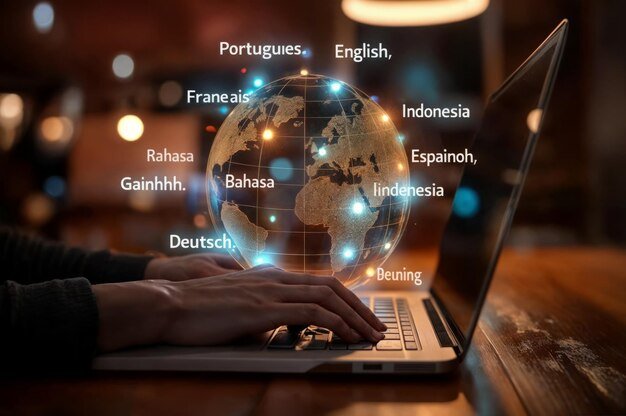Translation is more than just changing words from one language to another. It’s about conveying meaning, tone, and cultural nuances. A translator (Превоодач) plays a key role in breaking down language barriers and fostering communication across diverse cultures.
In our interconnected world, the demand for skilled translators is rising. From business negotiations to healthcare, their work impacts many sectors. This article explores the multifaceted role of a translator, the skills needed, and the challenges they face. It also highlights how technology influences the field and the importance of cultural sensitivity.
Join us as we uncover what it takes to be a successful Превоодач and the vital role they play in today’s global society.
The Art and Skill of Translation
Translation is a blend of technical expertise and creative expression. It goes beyond substituting words from one language to another; the translator must retain the original meaning, tone, and style while considering the cultural context of both the source and target languages.
Key skills for a translator include linguistic proficiency, which is not just about knowing the words but understanding the grammar, syntax, and idiomatic expressions of both languages. A strong translator grasps the nuances and variations in meaning that certain phrases can carry.
Cultural awareness is another important aspect. Languages are deeply rooted in the cultures they originate from, and translations often involve interpreting cultural references, humor, or idioms that may not have a direct equivalent in the target language. Successful translation keeps the message intact, even when the words must change.
Attention to detail is critical in translation work. Small differences in word choice or sentence structure can shift meaning in subtle but significant ways. A translator must carefully select terms that accurately convey the intended message, all while preserving the tone, whether it’s formal, casual, or emotional.
Additionally, translators often need strong research skills. They may encounter specialized terminology or industry-specific jargon that requires further understanding. This is common in technical, legal, or medical translations, where accuracy is paramount.
Time management is another essential skill, as translators often work under tight deadlines. Balancing speed with accuracy can be a challenge, especially when dealing with complex texts. However, a skilled translator knows how to prioritize tasks without compromising the quality of the final product.
Overall, the art of translation requires a mix of linguistic expertise, cultural sensitivity, and meticulous attention to the finer details. Translators must remain adaptable, applying their skills to different languages, industries, and contexts while always staying true to the original message.
Types of Translators and Their Specializations
Translators come in various forms, each specializing in different fields and types of translation. Understanding these specializations helps clarify the diverse skills required in the profession.

1. Literary Translators:
Literary translators focus on translating novels, poems, plays, and other forms of literature. This type of translation demands not only linguistic proficiency but also a deep appreciation for the art of storytelling. The translator must convey the author’s voice, style, and emotions while adapting cultural references for the target audience.
2. Technical Translators:
Technical translators handle texts related to technology, engineering, and science. This specialization requires a strong understanding of the subject matter, as well as the ability to translate complex terminology accurately. Technical translators often work on user manuals, product specifications, and research papers.
3. Legal Translators:
Legal translators work with documents related to law, such as contracts, court documents, and legal briefs. Precision is paramount in this field, as any errors can lead to significant consequences. Familiarity with legal terminology and practices in both the source and target languages is essential.
4. Medical Translators:
Medical translators deal with texts in the healthcare sector, including clinical studies, medical journals, and patient information. They must be well-versed in medical terminology and concepts, ensuring that the translations are accurate and easy to understand for both professionals and patients.
5. Financial Translators:
Financial translators focus on texts related to economics, finance, and accounting. They translate reports, investment documents, and financial statements. A solid understanding of financial terminology and market dynamics is necessary for this specialization.
6. Marketing Translators:
Marketing translators adapt promotional materials, advertisements, and website content for different markets. This type of translation requires creativity and a keen understanding of cultural nuances to effectively engage the target audience. Translators must capture the brand’s voice while ensuring the message resonates culturally.
7. Software and Website Localizers:
Localizers adapt software and websites for different languages and cultures. This involves translating not just the text but also adjusting visual elements and cultural references. Localizers ensure that the software functions correctly in the target language, which may include adapting features like date formats, currency, and user interface design.
8. Conference Interpreters:
While interpreters focus on spoken language, conference interpreters play a crucial role in facilitating communication during events. They provide real-time translation for speakers and attendees, requiring quick thinking and exceptional listening skills.
Each type of translator brings unique skills and expertise to the table. This diversity enriches the field, allowing for effective communication across various industries and cultures. Understanding these specializations is key to recognizing the value that translators add to our global society.
Translators vs. Interpreters: Understanding the Difference
While both translators and interpreters facilitate communication between languages, their roles and methods differ significantly. Each profession requires distinct skills and approaches, tailored to specific contexts.
1. Medium of Communication:
The primary distinction lies in the medium through which they operate. Translators work with written texts, transforming written documents from one language to another. This may include books, articles, websites, and legal documents. Their work allows for careful analysis, as they can revise and edit their translations before finalizing them.
In contrast, interpreters handle spoken communication. They provide real-time translation during conversations, speeches, or meetings. This requires quick thinking and the ability to convey messages instantly, often without the luxury of preparation or revision.
2. Types of Skills Required:
Translators need strong writing skills, a deep understanding of grammar and syntax, and the ability to maintain the original tone and style of the text. They must also have excellent research skills to accurately translate specialized terminology.
Interpreters, on the other hand, rely heavily on their listening and speaking abilities. They must grasp the context and nuances of spoken language quickly. Effective note-taking is also an essential skill, enabling interpreters to retain information during lengthy speeches or discussions.
3. Work Environment:
Translators often work in various settings, including offices, freelancing from home, or in collaboration with publishing houses or agencies. They typically have the flexibility to manage their time, allowing for a more structured work schedule.
Interpreters usually work in dynamic environments, such as conferences, business meetings, or legal proceedings. They often must adapt to changing situations and be prepared for last-minute assignments. The high-pressure nature of their work demands the ability to stay calm and focused in real-time.
4. Types of Translation:
The field of translation encompasses various specialties, such as literary, technical, legal, and medical translation. Each requires specific knowledge and skills relevant to the subject matter.
Interpreting also has its specializations, including conference interpreting, simultaneous interpreting, and consecutive interpreting. Each type serves different contexts and audiences, further distinguishing the two professions.
5. Interaction with the Audience:
Translators typically work behind the scenes, providing their translations for readers to consume without direct interaction. Their audience is often broader, as the translated material may reach diverse readers across the globe.
Interpreters engage directly with their audience. Their ability to convey messages effectively relies on their presence, tone, and non-verbal communication. This personal interaction can influence how the message is received and understood.
Understanding the differences between translators and interpreters highlights the unique contributions each makes to cross-cultural communication. Both professions are essential, but they serve distinct purposes in bridging language gaps. Each requires a dedicated skill set, tailored to the specific demands of their roles.
The Importance of Translators in Various Industries
Translators play a pivotal role across multiple sectors, facilitating effective communication and promoting understanding in our globalized society. Their work is crucial in several key areas, each with unique demands and challenges.
1. Business and Trade:
In the realm of business, translators are essential for companies looking to expand into international markets. They help translate marketing materials, product descriptions, and legal documents, allowing businesses to communicate effectively with potential clients and partners. Accurate translations foster trust and credibility, which are vital for successful negotiations and transactions.
2. Healthcare:
In healthcare, translators are instrumental in bridging communication gaps between medical professionals and patients. They translate medical records, consent forms, and informational brochures. Clear communication is critical in this field, as misunderstandings can lead to serious consequences for patient care. Translators help ensure that patients understand their conditions and treatment options, promoting better health outcomes.
3. Education:
The education sector relies heavily on translators for curriculum development, student exchanges, and academic research. Translators adapt educational materials, textbooks, and assessments, allowing institutions to reach diverse student populations. By providing access to quality education in multiple languages, translators contribute to inclusivity and equal opportunities for all learners.
4. Legal Field:
Translators are vital in the legal sector, where precision and accuracy are paramount. They translate contracts, court documents, and testimonies, ensuring that all parties understand their rights and obligations. Legal translators must have a deep understanding of legal terminology and concepts in both languages to avoid any misinterpretations that could affect legal proceedings.
5. Technology and Software Development:
As technology continues to evolve, the need for translation in software development and digital content increases. Translators localize software, websites, and applications, making them accessible to users around the world. This includes adapting user interfaces, error messages, and help documentation to meet the linguistic and cultural expectations of diverse user groups.
6. Tourism and Hospitality:
In the tourism industry, translators enhance the travel experience by providing accurate information about destinations, services, and cultural practices. They translate brochures, websites, and signage, helping travelers navigate new environments confidently. Effective translation in this sector promotes cultural exchange and enriches the overall travel experience.
7. Literature and the Arts:
Translators also play a significant role in the literary world, bringing works from one language to another. They enable readers to access literature from different cultures, broadening perspectives and fostering appreciation for diverse storytelling traditions. Their work helps preserve the original tone and style of the authors while adapting cultural references for new audiences.
8. International Relations:
In diplomacy and international relations, translators facilitate communication between countries. They work on documents, speeches, and treaties, playing a crucial role in fostering understanding and cooperation. Accurate translations can prevent misunderstandings that could lead to diplomatic tensions.
The importance of translators spans various industries, highlighting their role as cultural mediators and facilitators of communication. Their expertise not only aids in understanding but also fosters connections between people, businesses, and cultures. By bridging language barriers, translators contribute significantly to a more interconnected world.
Challenges in the Translation Process
The translation process is not without its challenges. Translators encounter various obstacles that can complicate their work and impact the quality of the final product. Understanding these challenges can help improve translation practices and outcomes.

1. Language Nuances:
Languages are filled with subtleties that can be difficult to translate. Idiomatic expressions, colloquialisms, and cultural references often do not have direct equivalents in another language. Translators must find creative ways to convey the same meaning without losing the essence of the original text. This requires not only linguistic skill but also a deep cultural understanding.
2. Maintaining Consistency:
Consistency is vital in translation, especially in long texts or projects involving multiple translators. Variations in terminology, style, and tone can lead to confusion and diminish the overall quality. Translators need to develop and follow style guides, glossaries, and reference materials to maintain uniformity throughout their work.
3. Deadlines and Workload:
Translators often face tight deadlines, which can create pressure and impact the quality of their work. Balancing multiple projects simultaneously can lead to burnout and stress. Effective time management and prioritization are essential to meet deadlines while maintaining high standards in translation.
4. Handling Specialized Content:
Translators frequently work with specialized terminology in fields such as law, medicine, or technology. Mastering the specific vocabulary and concepts of these fields is necessary for accurate translation. However, this can require extensive research and continuous learning to stay updated on industry developments.
5. Cultural Sensitivity:
Translators must navigate cultural differences that may affect how messages are perceived. What is acceptable in one culture may be offensive in another. Translators need to approach their work with cultural sensitivity, adapting content appropriately to avoid misunderstandings or negative reactions.
6. The Risk of Miscommunication:
Inaccurate translations can lead to miscommunication, resulting in serious consequences, particularly in legal or medical contexts. A single error can change the meaning of a statement, potentially leading to legal disputes or jeopardizing patient safety. Translators must be diligent and meticulous in their work to minimize these risks.
7. Emotional and Contextual Nuances:
Capturing the emotional tone of the original text can be challenging, especially when translating literary works. Translators need to convey not only the literal meaning but also the feelings and intentions behind the words. This requires a nuanced understanding of both languages and their cultural contexts.
8. Technological Adaptations:
With the rise of translation technology, translators must adapt to new tools and software. While technology can enhance efficiency, it also presents challenges. Relying too heavily on machine translation can lead to errors, as machines may struggle with context, idiomatic expressions, and emotional nuances. Finding the right balance between human expertise and technological assistance is crucial.
Translators face a variety of challenges that test their skills and adaptability. Overcoming these obstacles requires a combination of linguistic proficiency, cultural awareness, and practical strategies. By addressing these challenges, translators can produce high-quality translations that effectively convey meaning and context across languages.
The Impact of Technology on Translation
Technology has profoundly transformed the field of translation, shaping how translators work and the tools they use. This influence is evident in various aspects, from efficiency to accuracy and collaboration.
1. Translation Software:
The introduction of translation software has streamlined many aspects of the translation process. Programs like CAT (Computer-Assisted Translation) tools help translators manage projects more effectively. These tools store previously translated segments, enabling consistent terminology usage across different projects. Translators can quickly access glossaries and style guides, improving productivity and accuracy.
2. Machine Translation:
Machine translation (MT) has gained prominence with advancements in artificial intelligence and natural language processing. Systems like Google Translate can provide instant translations for large volumes of text. While MT can serve as a useful starting point, it often struggles with context, idiomatic expressions, and cultural nuances. As a result, human translators play a vital role in editing and refining machine-generated translations to ensure quality.
3. Online Resources:
The availability of online dictionaries, thesauruses, and linguistic resources has expanded the tools at a translator’s disposal. Translators can easily access a wealth of information to assist with terminology and research. Online forums and communities also provide platforms for collaboration and support among translators, allowing them to share knowledge and best practices.
4. Collaboration Tools:
As translation projects become more complex, collaboration tools facilitate teamwork among translators, editors, and project managers. Platforms such as shared document editors and project management software enable real-time communication and updates. This fosters a more efficient workflow, particularly for large projects that require input from multiple team members.
5. Quality Assurance:
Technology also enhances quality assurance processes in translation. Software can help identify inconsistencies, formatting errors, and grammatical issues. This assists translators in producing polished final products while minimizing the risk of oversight.
6. Remote Work Opportunities:
Advancements in technology have made remote work more accessible for translators. They can collaborate with clients and colleagues worldwide, expanding their opportunities beyond geographical limitations. This flexibility allows for a broader client base and varied projects, enriching their professional experience.
7. Emerging Technologies:
New technologies such as artificial intelligence, machine learning, and neural networks are continually evolving the translation landscape. These advancements promise even more sophisticated translation capabilities, improving accuracy and contextual understanding. However, they also raise questions about the future role of human translators and the balance between technology and human input.
8. Ethical Considerations:
With the integration of technology, ethical considerations come to the forefront. Issues related to data privacy, intellectual property, and the reliability of machine-generated translations are increasingly important. Translators must navigate these challenges to uphold professional standards and protect client information.
Technology has reshaped the translation industry, providing tools that enhance productivity, accuracy, and collaboration. While machines can assist in the translation process, the expertise and insight of human translators remain indispensable. By combining technological advancements with linguistic skill, translators can continue to deliver high-quality translations that meet the needs of an evolving global marketplace.
Cultural Sensitivity and Its Role in Effective Translation
Cultural sensitivity is a fundamental aspect of successful translation, impacting how messages are conveyed and perceived. Translators must navigate the complexities of different cultures to deliver accurate and meaningful translations.
1. Understanding Cultural Context:
Each language is embedded in its cultural framework, influencing how individuals communicate. Translators must grasp the context behind phrases, idioms, and references that may not be directly translatable. This involves recognizing societal norms, values, and traditions that shape language usage. Without this understanding, translations can miss the mark, leading to misinterpretations.
2. Adapting Content for Cultural Relevance:
A literal translation may not always resonate with the target audience. Cultural references, humor, and societal issues vary widely between cultures. Translators often need to adapt content to align with the cultural expectations of the audience. This might involve changing metaphors, idioms, or examples to ensure the message feels relevant and engaging.
3. Avoiding Cultural Pitfalls:
Translators must be aware of cultural sensitivities to avoid offending or alienating the target audience. Certain words, phrases, or imagery may carry negative connotations or provoke unintended reactions. By researching and understanding these cultural nuances, translators can mitigate risks and foster positive communication.
4. Respecting Diversity and Inclusivity:
Cultural sensitivity also involves recognizing diversity within cultures. Different regions, ethnic groups, and communities may have unique dialects, traditions, and perspectives. Translators should be attuned to these variations to provide translations that reflect the diversity of the target audience. This promotes inclusivity and acknowledges the richness of cultural identities.
5. Building Trust and Credibility:
When translators demonstrate cultural sensitivity, they build trust with their audience. A translation that respects cultural norms conveys professionalism and a commitment to quality. Clients are more likely to value the work of translators who understand and appreciate cultural differences, leading to stronger relationships and repeat business.
6. The Role of Research:
Thorough research is essential for understanding cultural contexts. Translators often need to explore historical, social, and political factors that influence language and communication styles. Staying informed about current events and cultural trends can also enhance a translator’s ability to produce relevant and effective translations.
7. Continuous Learning:
Cultural sensitivity is not a one-time consideration; it requires ongoing learning and adaptation. Languages and cultures evolve over time, and translators must keep pace with these changes. Engaging with diverse communities, attending cultural events, and participating in training can enhance a translator’s cultural awareness and effectiveness.
8. Collaboration with Cultural Experts:
In some cases, collaborating with cultural experts or native speakers can enrich the translation process. These experts can provide valuable insights into cultural nuances, helping translators make informed decisions about language choices and content adaptations. This collaboration can lead to translations that resonate more deeply with the intended audience.
Cultural sensitivity is integral to effective translation, shaping how messages are received across languages. By prioritizing cultural understanding, translators can create translations that resonate with their audiences, foster meaningful connections, and contribute to effective cross-cultural communication.
Case Studies: Successful Translation Projects
Examining real-world examples of successful translation projects highlights the significance of skilled translators and their impact across various fields. These case studies illustrate how effective translation can facilitate communication, enhance cultural exchange, and drive business success.

1. International Business Expansion:
A multinational corporation aimed to launch a new product line in multiple countries. The marketing team recognized the need for culturally relevant advertisements and promotional materials to resonate with local audiences. By employing a team of experienced translators and cultural consultants, the company was able to adapt their messaging for different markets. This included not only translating the text but also reworking visuals and slogans to align with cultural values. As a result, the product line saw a successful launch, significantly increasing sales and brand recognition in the target markets.
2. Legal Document Translation:
A law firm representing an international client needed to translate a complex contract involving parties from different countries. The document contained intricate legal terminology and specific clauses that required precise translation to avoid disputes. The firm hired a legal translator with expertise in both jurisdictions. By thoroughly understanding the nuances of both legal systems, the translator provided an accurate translation that maintained the original intent and legal validity. The client appreciated the diligence, leading to a successful agreement and ongoing collaboration with the law firm.
3. Literary Translation of a Bestseller:
A renowned author’s novel was set to be published in multiple languages. The publisher sought a translator who could capture the author’s voice while making the text accessible to new audiences. The selected translator had extensive experience in literary translation and a deep appreciation for the author’s style. They worked closely with the author to ensure the translation retained the original tone and emotional depth. The translated version received critical acclaim and opened new markets for the author, showcasing the power of literary translation in bridging cultures.
4. Healthcare Information Dissemination:
In a bid to improve patient care for non-native speakers, a healthcare organization decided to translate its patient information materials. They recognized that language barriers could hinder patient understanding and compliance with medical instructions. The organization collaborated with medical translators to create clear and accurate materials in several languages. These resources helped patients understand their treatment options and health conditions, ultimately leading to improved health outcomes and patient satisfaction.
5. Website Localization for a Tech Company:
A tech company aimed to enter international markets with its software product. They recognized that a simple translation of the website would not suffice; instead, they needed a full localization strategy. This involved translating content, adapting the user interface, and modifying functionalities to fit local preferences. By employing local experts and translators, the company successfully localized their website, making it user-friendly and culturally relevant. This initiative resulted in a significant increase in global user engagement and software adoption.
These case studies exemplify the essential role of translation in various sectors. They demonstrate how effective translation practices can drive success, enhance communication, and foster positive relationships across cultures. By highlighting these successful projects, it becomes clear that skilled translators are invaluable assets in today’s interconnected world.
Conclusion
The role of a translator (Превоодач) extends far beyond mere word-for-word conversion; it is a vital profession that bridges cultural gaps and fosters effective communication in an increasingly globalized world. From business and healthcare to literature and technology, translators are essential in ensuring that messages are accurately conveyed while respecting cultural nuances. As technology continues to evolve, translators must adapt and embrace new tools and methodologies to enhance their work. Their expertise not only enriches individual interactions but also strengthens international relationships, drives economic growth, and promotes understanding across diverse communities. The significance of translators cannot be overstated, as they play a key role in making our world more connected and accessible.
FAQs
1. What qualifications do I need to become a translator?
To become a translator, you typically need a strong command of at least two languages, including your native language. A bachelor’s degree in translation, linguistics, or a related field can be beneficial. Additionally, specialized training in specific areas, such as legal or medical translation, can enhance your qualifications.
2. How do translators ensure accuracy in their work?
Translators ensure accuracy by thoroughly understanding the source material and the target language’s nuances. They often use translation memory software and glossaries to maintain consistency and precision. Additionally, many translators review their work multiple times and may collaborate with subject matter experts to verify technical terminology.
3. What types of documents can translators work on?
Translators can work on a wide variety of documents, including literary works, legal contracts, technical manuals, marketing materials, websites, and medical records. The type of document often determines the level of expertise required, as specialized fields may have unique terminology and conventions.
4. How has technology impacted the translation industry?
Technology has significantly impacted the translation industry by introducing tools like computer-assisted translation (CAT) software, machine translation, and online collaboration platforms. These advancements improve efficiency and consistency in translations, but they also require translators to adapt and integrate these tools into their workflow.
5. What is the difference between a translator and an interpreter?
A translator works with written texts, converting documents from one language to another, while an interpreter deals with spoken language, providing real-time translation during conversations or speeches. The skills required for each role differ, with translators focusing on writing and research, and interpreters emphasizing listening and speaking abilities.










